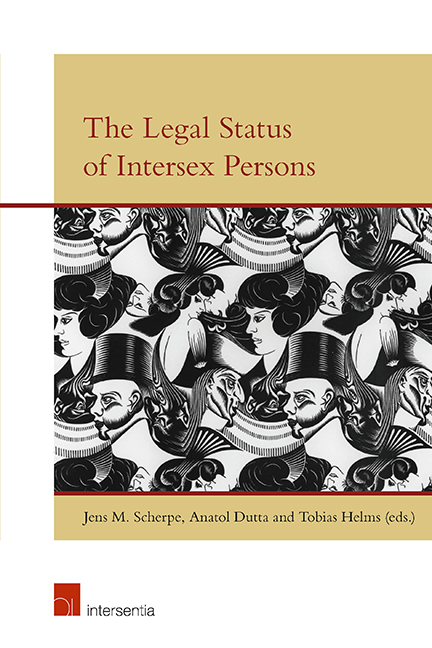Book contents
- Frontmatter
- Preface
- Contents
- List of Contributors
- The Legal Status of Intersex Persons: An Introduction
- Malta Declaration
- Darlington Statement
- Vienna Statement
- PART I MEDICINE AND PSYCHOLOGY
- PART II THEOLOGY AND LEGAL HISTORY
- Intersex in the Christian Tradition: Personhood and Embodiment
- Four Sexes, Two Genders: The Rabbinic Move from Legal to Essentialist Polarisation of Identities
- Intersex: Some (Legal-)Historical Background
- PART III TRANSGENDER, TRANSSEXUALITY AND INTERSEX
- PART IV NATIONAL LEGAL DEVELOPMENTS
- PART V PRIVATE INTERNATIONAL LAW ASPECTS OF INTERSEX
- PART VI INTERSEX AND HUMAN RIGHTS
Four Sexes, Two Genders: The Rabbinic Move from Legal to Essentialist Polarisation of Identities
from PART II - THEOLOGY AND LEGAL HISTORY
Published online by Cambridge University Press: 31 January 2019
- Frontmatter
- Preface
- Contents
- List of Contributors
- The Legal Status of Intersex Persons: An Introduction
- Malta Declaration
- Darlington Statement
- Vienna Statement
- PART I MEDICINE AND PSYCHOLOGY
- PART II THEOLOGY AND LEGAL HISTORY
- Intersex in the Christian Tradition: Personhood and Embodiment
- Four Sexes, Two Genders: The Rabbinic Move from Legal to Essentialist Polarisation of Identities
- Intersex: Some (Legal-)Historical Background
- PART III TRANSGENDER, TRANSSEXUALITY AND INTERSEX
- PART IV NATIONAL LEGAL DEVELOPMENTS
- PART V PRIVATE INTERNATIONAL LAW ASPECTS OF INTERSEX
- PART VI INTERSEX AND HUMAN RIGHTS
Summary
Early Rabbinic Judaism is the name given to the group of people who produced, from the first to approximately the seventh century CE, the post Biblical canonic texts of Judaism. This ‘new’ Judaism, which grew in parallel to early Christianity, was highly invested in the concept of law. This is reflected not only in interpreting the Hebrew Bible which is considered to be a book of laws, but also in the production of a legal codex of their own time (the Mishnah, edited in the early third century), and its interpretations (the Palestinian Talmud, edited in the fifth century, and the Babylonian Talmud, which had several layers of editing, the latest of which is in the seventh century). These legal codices still serve as the basis for any ruling on questions relating to intersex people in Jewish law, and often in Israeli law.
In this chapter we wish to portray the ways in which rabbinic literature bridged the gap between a classification system which acknowledges more than two sexes, and a legal system (based on the Biblical law) which only thinks with two sexes and two genders, or rather, does not differentiate between sex and gender. We also wish to point to an historical process by which the recognition of existence of more than two sexes was gradually rejected, as the binary categories of men/women and gender division became more important and constructed. Rabbinic literature is an interesting locus not only of itself, but also in comparison to Roman law and modern law. It addresses gender and sex division in a manner that echoes the ways we tend to think of as modern and born out of the spirit of feminism and deconstruction. Those ancient Jewish texts ask: are there indeed only two sexes? Does the mere recognition that there are indeed more create any implications to the status of such individuals in society? How does a legal system, which is based on a code that only recognises two sexes, incorporate and interpret the natural and discursive reality of more?
What we will show is that while rabbinic literature is able to acknowledge and even categorise different intersex people, the legal system often pushes those people into gender categories as either men or women.
- Type
- Chapter
- Information
- The Legal Status of Intersex Persons , pp. 165 - 180Publisher: IntersentiaPrint publication year: 2018

